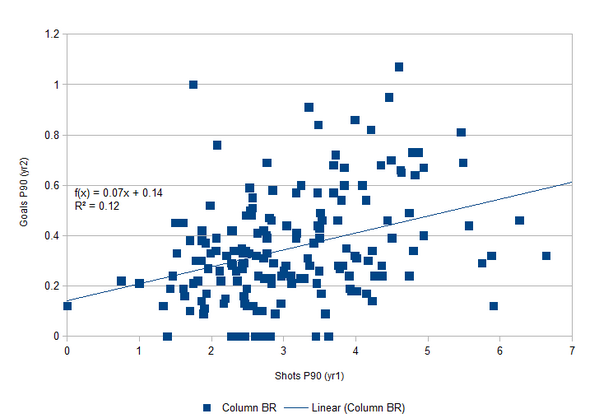This article originally appeared on Statsbomb
Overview
The
two most ubiquitous stats for attackers are goals and assists. And why shouldn’t they? After all, goal differential explains ~85% of
the variance in a league table. Creating
goals is a very valuable skill. But how
repeatable of a skill is it? After
scoring 11 goals in his first 19 EPL games for Newcastle United in 2010, Andy
Carroll was sold to Liverpool for a staggering 35 million pounds. Carroll would score only six times in his
next 44 EPL appearances before he was loaned out and subsequently sold to West
Ham. I do not bring up Carroll because I
think he was a poor acquisition for Liverpool, I bring him up because he
exemplifies the variable nature of goalscoring.
When it comes to goals and assists, what is the signal and what is the
noise?
Key
Passes are better than Assists
The
original intent of this piece was to test the persistence or repeatability of
key passes. To the uninitiated, key
passes are passes that directly lead to an attempt on goal. There has been some legitimate criticism of
the fact that key passes don’t take proper account of the quality of the
chances being created, but for now it’s the metric we have. I looked at every player in the EPL who
averaged over 0.7 key passes per 90 in any season from 2009-2013. I then looked at the year over year
relationship for key passes: how well do
year 1 key passes predict year 2 key passes (n=184)? Quite well, it turns out. While not overwhelming, the relationship is
evidence that key passes are a somewhat repeatable statistic.
Next,
I took the same sample and looked at how well year 1 assists predicted year 2
assists. There really isn’t a
relationship. Assists are basically
random from year to year.
On
a hunch, I looked at how well year 1 key passes predicted year 2 assists.
Granted,
this is not a great relationship either, but it is significant that key passes
actually predict assists better than assists.
And, unlike assists, key passes have some degree of repeatability.
Shots
are better than Goals
Earlier
this year Ben Pugsley undertook a similar study, but he primarily looked at
shooting statistics. The statistic with
the best predictive relationship? Shots
per 90.
Ben
also found no year over year relationship for assists (although his r^2
differed slightly from mine) or goals (below).
Ben
was kind enough to, as I had done with key passes and assists, run a regression
comparing year 1 shots to year 2 goals.
As
with key passes and assists, shots predict goals better than goals predict
goals. Of course an r^2 of 0.12 is
hardly predictive, but at this point in soccer analytics knowing what does not
work is just as important as finding out what works.
Expected
Goals Created Model
So
if goals and assists don’t work, what might?
Key passes and shots, taken at their face, are not nearly sophisticated
enough. Luckily, much work has been done
on shot location/type and expected goals (here and here and many other places). As far as I know, adjusting for shot
location/type hasn’t been attempted yet for shots resulting from key passes,
but that is a logical next step.
Theoretically, an expected goal and expected assist model would be the
best predictor.
Goals
and assists are the unpredictable results of a more repeatable underlying
process. By understanding and
quantifying this process, we can move towards the signal and away from the
noise.






No comments:
Post a Comment